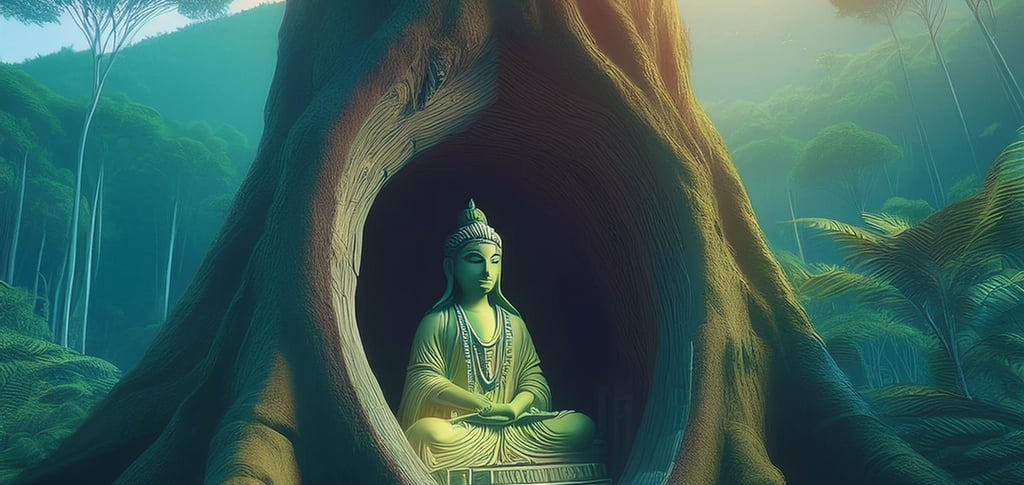Sacred Guardian: The Story of the Bayan Tree in Toya Ubud
Myth/Legend


In the heart of Bali, where the air is thick with the scent of frangipani and the sound of temple bells echoes through the hills, the presence of towering trees holds a special place in the island’s spiritual landscape. These trees, with their ancient roots and sprawling branches, are not just symbols of nature’s grandeur—they are vessels of spiritual energy, sacred beings that connect the human world with the divine. Among these revered trees stands one of great significance: the Bayan Tree, known in Balinese as Pohon Aa Baas. This majestic tree, now a sacred presence in Toya Ubud, carries within it a story of mystical power, resilience, and a journey that has spanned over a century.
The story of the Bayan Tree begins far from its current home. In the tranquil village of Les in Singaraja, about 55 kilometers from Toya Ubud, an ancient tree had stood for more than a century, silently observing the lives of the people around it. The elders of Les village speak of this tree with reverence, recalling how, even in their youth, the Bayan Tree was already a towering giant—its roots deeply entwined with the earth, its branches reaching toward the sky, as if in a perpetual state of prayer.
This was no ordinary tree. The people of Les believed that the tree was inhabited by mystical beings, that it possessed the ability to heal, to bring fortune, and to protect those who sought refuge beneath its shade. Adorned with poleng, the checkered black-and-white cloth symbolizing balance and sacredness, the Bayan Tree was recognized as a spiritual guardian. It stood as a reminder of the unseen forces that weave through Bali’s natural and spiritual worlds.
But the most extraordinary feature of this ancient tree lay within its hollow trunk. Large enough for a person to enter, this hollow housed a statue of a resi, a holy hermit. The Pandita statue, nestled within the tree, was a symbol of purity and spiritual enlightenment. It was said that anyone who prayed within the tree could find healing, both physical and spiritual, and could even transform their misfortunes into blessings.
For generations, the Bayan Tree was a place of pilgrimage for those burdened by life’s trials. People would come from near and far to sit within its hollow, to meditate in its quiet sanctuary, and to seek solace from the turbulence of life. The tree was not just a part of the landscape—it was a living symbol of wisdom, divine blessing, and protection.
A Threat to the Sacred Tree
However, even sacred beings face danger in the modern world. As time passed, the future of the Bayan Tree became uncertain. There were whispers in Les village of plans to fell the tree, to use its ancient wood for firewood. The very thought of such a fate was heartbreaking to those who understood the tree’s spiritual significance. Its death would be more than the loss of a tree—it would be the end of a sacred protector, a source of healing, and a vessel of divine energy.
But not everyone was willing to let the tree disappear into history. I Ketut Mardjana, the visionary founder of Toya Ubud, felt a profound connection to the Bayan Tree and could not bear the thought of its destruction. He had long believed in the tree’s mystical properties and saw it as a powerful symbol of healing and resilience. To him, the tree was more than just a piece of nature—it was a spiritual beacon, one that belonged not just to Les village, but to all who sought its blessings.
And so, Ketut Mardjana embarked on a mission to save the Bayan Tree. It was a task fraught with difficulty, but his determination was unwavering. He knew that the tree could not be allowed to die—not when it held such immense spiritual power.
Relocating an ancient tree is no small feat. The Bayan Tree had stood in Les for over a hundred years, its roots deeply embedded in the earth. To move it would require not only skill and strength, but also immense care. Ketut Mardjana assembled a team of five skilled workers and brought in an excavator to carefully dig up the tree’s roots. Each movement had to be precise, as the tree’s life depended on its roots remaining intact.
After hours of meticulous effort, the Bayan Tree was finally uprooted, ready to begin its journey to Toya Ubud. The tree was placed on a large truck, its branches carefully wrapped to prevent damage, and it began its long journey across the island. The people of Les watched with mixed emotions—sorrow that the tree was leaving its original home, but hope that it would continue to live and thrive in its new sanctuary.
Upon arriving at Toya Ubud, the replanting process began. This was no less a challenge than the uprooting. A team of ten dedicated individuals worked tirelessly to ensure that the Bayan Tree was securely planted in its new home. Every detail was attended to, from the positioning of its roots to the angle of its branches. Each day, the tree was watered 8-10 times, cared for with the same devotion one might give to a newborn child.
Over time, the Bayan Tree began to settle into its new surroundings. Its leaves grew lush once again, and its roots stretched out into the fertile soil of Toya Ubud. It had survived the journey, and now it stood tall once more, its presence even more powerful than before.
The Tree of Healing and Wisdom
Today, the Bayan Tree stands as a central figure in Toya Ubud, a place of healing, reflection, and spiritual connection. Visitors from all corners of the world come to see the tree, not just for its age or size, but for the sense of peace it brings. Beneath its sprawling branches, people gather to meditate, to offer prayers, and to seek solace in its shade.
The hollow trunk of the Bayan Tree remains a sacred space. Within it, the statue of the Pandita continues to offer blessings to those who enter. It is said that the tree’s mystical powers have only grown stronger since its relocation, that the energy it radiates can bring clarity to the troubled mind, and healing to the weary soul.
Next to the Bayan Tree, a statue of Ganesha, the god of wisdom, protection, and prosperity, has been placed. Together, the Bayan Tree and Ganesha embody the ideals of peace, balance, and abundance—core values of Toya Ubud. The tree, with its deep roots and towering presence, represents resilience and the wisdom of the natural world, while Ganesha, with his gentle yet powerful form, offers protection and guidance to all who seek it.
The story of the Bayan Tree is one of resilience, transformation, and the enduring power of the sacred. It is a story of how a tree, once threatened with destruction, was saved by those who recognized its spiritual significance and gave it new life in a place where it could continue to inspire and heal.
Today, the Pohon Aa Baas stands as more than just a tree—it is a living testament to the power of belief, the strength of nature, and the importance of preserving the sacred in our world. Its story will continue to be told for generations to come, as visitors to Toya Ubud sit beneath its branches, feeling the presence of something far greater than themselves—a connection to the divine that transcends time and place.
123-456-7890 hello@toyaubud.com
Jl. Raya Kenderan, Tegalalang, Gianyar - Bali 80561


Toya Ubud is part of the renowned Toya Devasya group, a leader in Bali's wellness and nature-focused tourism. Committed to sustainable tourism, Toya Ubud blends eco-conscious practices with authentic cultural experiences, ensuring that visitors connect with nature while preserving the environment.
